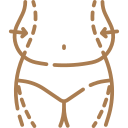Body Contouring
Striae/ Stretch Mark
Stretch marks, also known as striae, are a common skin concern that typically occur when the skin undergoes rapid stretching or changes,commonly appear on the abdomen, buttocks, inner thighs, and breasts. These marks appear as long, streak-like lines on the skin’s surface and can affect an individual’s appearance and confidence. Striae often seen in:
Pregnancy: During pregnancy, the skin stretches rapidly as the abdomen expands, leading to the rupture of collagen and elastic fibers, resulting in stretch marks.
Weight Fluctuations: Sudden increases or decreases in weight can cause the skin to be overstretched or contracted, affecting the skin’s structure and leading to stretch marks.
Growth Spurts: Adolescents may develop stretch marks during periods of rapid growth, particularly in areas such as the thighs, buttocks, and back.
Genetic Factors: Individuals with family members who have experienced stretch marks are more likely to develop similar issues.
Hormonal Changes: Fluctuations in hormone levels, especially increased estrogen and cortisol during pregnancy, can affect skin elasticity, contributing to the formation of stretch marks.
Characteristics of Stretch Marks:
Early Signs: In the initial stages, stretch marks may appear red, pink, or purple due to the visibility of blood vessels beneath the skin’s surface. These marks are often raised and may be accompanied by itchiness.
Late Signs: Over time, the color of stretch marks gradually fades to white or silver, and the raised texture becomes flatter. This color change in late-stage stretch marks is due to reduced pigmentation and skin healing.
Stubborn Fat
Stubborn fat refers to fat that is difficult to reduce in specific areas through traditional diet and exercise methods. These areas typically include the abdomen, thighs, buttocks, and upper arms, where fat cells tend to be more resistant to conventional weight loss methods.
Characteristics of Stubborn Fat:
Localized Fat Accumulation: Stubborn fat often concentrates in certain parts of the body, such as the abdomen, inner thighs, buttocks, and arms. Fat in these areas is typically more challenging to eliminate, even if overall body weight decreases.
Resistance to Reduction: Even with strict dietary control and regular exercise, fat in certain specific areas often remains difficult to reduce. This is due to the lower metabolic rate of fat cells in these areas, which slows down the breakdown of fat.
Slow Metabolism: The fat cells in these regions have a lower metabolic rate, resulting in a less efficient mobilization and elimination process for fat, making accumulation more persistent.
Causes of Stubborn Fat Formation:
Genetic Factors: Genetics play a significant role in fat distribution. Some individuals are predisposed to accumulate fat in specific areas, making it harder to reduce fat in those regions.
Hormonal Changes: Imbalances in hormone levels, such as increased insulin, estrogen, and cortisol, can lead to fat accumulation in certain areas. For example, hormonal fluctuations may promote the deposition of fat in the abdominal area.
Age Factors: As we age, metabolism gradually slows down, and the body’s ability to process fat decreases. In particular, fat in areas prone to accumulation becomes harder to effectively break down and eliminate.
Lifestyle: Sedentary behavior, irregular eating habits, and high-stress levels can promote fat accumulation and exacerbate issues with stubborn fat. These factors influence the body’s fat metabolism and distribution.
Loose Skin
Abdominal skin laxity typically occurs under the following circumstances:
Weight Loss: After rapid weight loss, the skin may not have enough time or elasticity to readjust to the changes in body shape, resulting in loose skin and the appearance of wrinkles or sagging.
Pregnancy: During pregnancy, the skin on the abdomen undergoes significant stretching as the fetus grows. After childbirth, the skin may struggle to return to its original state, leading to laxity.
Aging: As we age, the levels of collagen and elastin in the skin gradually decrease, resulting in reduced elasticity and the onset of sagging.
When skin elasticity decreases, it cannot fully retract, leading to laxity and wrinkles.



